« February 2009 | Main | April 2009 »
March 30, 2009
Philadelphia Film Festival 2009: 4bia

See Prang
Youngyooth Thongkonthun, Banjong Pisanthanakun, Parkpoom Wongpoom, and Paween Purikitpanya - 2008
GTH 35mm film
Once you get past the pun on the word "phobia", 4bia is a fairly straight-forward collection of four short Thai ghost stories. The stories could be viewed separately, although the sharp eyed viewer is advised that each story has a connection either to characters in varying chronological order. These stories were made primarily for a young Thai audience that has grown up with the culture of a belief in ghosts and the ghost movie genre. Ideally, as in Thailand, this is the kind of film that should be seen in a theater with lots of screaming teenagers.
The first story, Happiness, is about a young woman, Pin, stuck in her apartment while her broken leg is still in a cast. One hundred days following an accident in a taxi, she has nothing to do except the occasional online chat or text messages. A stranger begins sending text messages. Pin is at first delighted, and then frightened as the person has the ability to know her and what she is doing, even though he remains unseen. Writer-director Youngyooth Thongkonthun is best known to western audiences for his two Iron Ladies films, about a gender bending volleyball team. There is no comedy here, but Youngyooth creates a sense of poignancy in his story about loneliness.
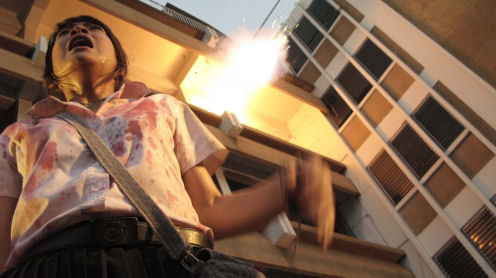
Tit for Tat reminded me of the first Thai film I saw in Thailand, Letters of Death, only shorter and better. Paween Purikitpanya's story is about the bullied high school boy who get revenge. It's the most graphic of the four films, perhaps not surprising as Paween is best known for his feature, Body #19. The mayhem is familiar, death by spontaneous combustion, large steel rods, or seemingly secured large objects that fall on top of the hapless victim. There is a delicious plot twist when one of the girls who witnessed the bullying is left alone at a police station room. I'm not sure if it was intended, but without giving too much away, the end reminded me of the apocryphal ending for one of Roger Corman's films. Bloody fun? Hell, yes.
The second two segments were written and directed by Banjong Pisanthanakun and Parkpoom Wongpoom, known for their collaborative efforts on Shutter and Alone. Banjong's In the Middle is about four young men on a rafting trip. One tells the other three about a camper sighting a female ghost while camping in the jungle. Jokes are told about haunting each other should one of them dies while on their excursion. The next day, the raft overturns, with Aey rescuing a drowning, panic stricken Ter. Aey seems to have disappeared into the water only to return cold and wet the next day. Banjong's story has the characters telling each other plot points from other films such as The Sixth Sense and Titanic, playing both with the genre of the Thai ghost story and popular films involving either ghosts, death by drowning or both. Additionally, Banjong also has fun with both the characters and the audiences familiarity with the films and genre expectations.
One last verbal pun is found in giving Parkpoom Wongpoom's episode the title, Last Fright. The story is about a stewardess who is requested to serve on the flight of a princess from a Middle Eastern country. The stewardess, Pim, had been on the flight the princess had previously taken when she visited Thailand with her husband, a prince who has since divorced her. The only passenger, the princess proves to be extremely demanding. The relationship between the two women is eventually revealed. Let me only say that Pim and the princess are together on a second flight, as before the only people in the passenger section of the plane, on a flight some of us would find scary enough with the plane bobbing about amidst turbulence in the dark. Parkpoom builds on the suspense of being in an enclosed space, with no way to escape. If their solo work is any indication, it would appear that Banjong was the primary author of Shutter with a story about a group of haunted young men, while Parkpoom is more interested in women in peril, inadvertently of their own making.
4bia has been both a top commercial hit in Thailand, as well as a critical success. 4bia will screen March 31, April 1 and 3.
Posted by Peter Nellhaus at 12:43 AM
March 29, 2009
Coffee Break

Han Suk-kyu in The Scarlet Letter (Daniel H. Byun - 2004)
Posted by Peter Nellhaus at 12:31 AM
March 28, 2009
Philadelphia Film Festival 2009: The Chaser

Chugyeogja
Na Hong-jin - 2008
Showbox 35mm film
What makes The Chaser worth seeing is not so much the twists and turns of the plot, as much as how the main character, a pimp named Joong-ho, slowly becomes sympathetic, if not totally heroic. Unlike some of the recent Korean films I've seen, part of what is shown of Seoul is not the glitzy, modern city of towering apartments, but a section of older houses with streets that turn into cul-de-sacs and barely a pedestrian to be seen.
Jung-ho thinks his girls are running away or have been taken by a competitor. Realizing that the disappearance of some of the girls coincides with appointments with one of the clients, Jung-ho seeks out the man. What is discovered is more than imagined. The police are brought in, but what ensues is an investigation bungled by incompetence, competing units, and misdirected pride. At the same time Jung-ho is seeking out his mystery man, the Mayor of Seoul is daubed with shit from a protester. For a while it seems like protecting the Mayor takes priority. In spite of obstacles, Jung-ho bulldozes his way to bring the man, Young-min, to justice.
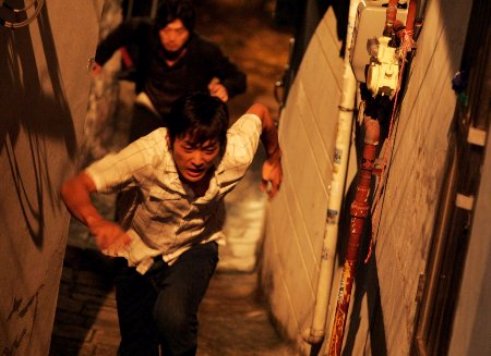
Taking place over the course of two days, the film depicts Jung-ho's changing relationship with women. For Jung-ho, the prostitutes that work for him are primarily commodities, their value based on how much money they bring in. For the clients, the prostitutes are only of worth in their compliance in fulfilling the demands of the client, no matter how extreme. Jung-ho presents himself as "the guardian" to one of the women when it is discovered that there is more than one man in a hotel room. It is when Jung-ho discovers that the woman, Mi-jin, he sent out to meet Young-min, has a young daughter that he truly takes on the role of guardian.
Just like the streets where some of the action takes place, The Chaser doesn't take a straight path in its narrative. Na Hong-jin makes the film work slowly but surely to create a suspenseful finish. Some of the graphic brutality is less gratuitous as the story develops. By the end of the film, Na needs only to ignite the viewers imagination as to what has become of Young-min's victims. That The Chaser is a well made thriller by current standards should be mentioned. What was not expected was that by the last half hour, Na's feature debut became emotionally wrenching.
The Chaser is screening March 30 and April 1.
Posted by Peter Nellhaus at 12:33 AM
March 25, 2009
Philadelphia Film Festival 2009: GS Wonderland

GS Wandarando
Ryuichi Honda - 2008
DesperaDo 35mm Film
My first introduction to anything resembling Japanese rock music was courtesy of Dick Clark, on a show he hosted on Saturdays. I don't remember the band's name, but I do remember that they performed a cover version of "Where Have All the Flowers Gone?". After that long time passing, my only exposure to Japanese rock has been intermittent. Some of what I've seen and heard could be marked off as being peculiar to someone who grew up during the era of The Beatles.
GS Wonderland is a very funny movie about a brief era in Japanese popular music. This interview with Ryuichi Honda is of help in explaining the context of his film. The songs are by Kyohei Tsutsumi and Jun Hashimoto, the equivalent to the Brill Building composers who churned out hits performed by various singers of the moment back in the early Sixties. The music is closer to Bubblegum than to actual rock music, but that's just part of the film's goofy charm.

The film is about the quick rise and fall of a band. Chiaki Kuriyama plays Michio, a young woman and rock wannabe, who's talked into joining a trio of three young men to form a band, with her disguised as a male named Mick. As The Diamonds, the group's first single flops, selling only twenty-three copies. Executives coming up with an angle to make the band different in looks from other bands come up with the idea of the band members wearing tights. With a new name, The Tightsmen, the future looks dismal until young women glom onto the appeal of Mick.
In addition to the humor of Mick becoming the most popular band member, there is the rivalry with the band, The Knuckles, and a vocal quartet who are less fresh than their name might suggest. Honda borrows from The Beatles rooftop concert, as well as the most famous scene from It Happened One Night. There is also a running gag with lead singer of The Knuckles claiming that Paul McCartney and Ringo Starr are hiding out in northern Japan, giving lessons to would be rockers.
Hopefully, GS Wonderland will get a DVD release, if not more theatrical showings in the U.S. Chiaki Kuriyama again plays a strong willed young woman, but a warmer role than of Gogo Yubari in Kill Bill. With her angular features and long neck, one could imagine Kuriyama as the subject of one of Modigliani's paintings. Even if the film ignores the real female musicians of the time, it is an amusing pastiche of a past era, with laughs that will bridge any gaps in time and culture.
GS Wonderland is screening on March 29, 31 and April 1.
Posted by Peter Nellhaus at 12:17 AM | Comments (1)
March 23, 2009
Philadelphia Film Festival 2009: 20th Century Boys

20-seiki shonen
Yukihiko Tsutsumi - 2008
Toho Company 35mm film
With much thanks to Lewis Tice of TLA Releasing, I will be writing about some of the the films shown at the Philadelphia Film Festival from my abode in Littleton, Colorado. W.C. Fields to the contrary, I would think that many cinephiles would want to be in Philadelphia, if not for the films I'll be covering, than for some of the other work to be presented.
I've only seen one other film by Yukihiko Tsutsumi. 2LDK is a small scale piece, essentially two women in their shared apartment. The two women also happen to be struggling actresses coveting the same role. While waiting for the phone call that let's them know who won the part, the two engage in an escalating battle using their wits, physical abilities and various household appliances.

20th Century Boys is the opposite in that it is a sprawling epic. Most of the film jumps between 1970 and 1997, the year that a group of school children create their own club, and the year they come together following a school reunion. In 1970, one of the boys, Kenji, writes and draws what is titled, "The Book of Prophesies". A childhood fantasy about the apocalyptic end to the 20th Century, the incidences described are manifest by someone who knew Kenji and was familiar with the long-buried book. A blood draining virus and acts of destruction are secretly the work of someone who calls himself Friend, the unknown person from Kenji's childhood. Friend is the leader of a cult that has amassed a large following as well as political influence. Pegging Kenji as the terrorist responsible for Friend's acts, Kenji and his childhood friends band together to fight Friend and reveal the truth about his goals.
It should be noted that this is the first part of two films. To judge 20th Century Boy as a stand alone feature would be unfair as much of the film is a set-up for the second part which film festival attendees will be able to see. The original manga, the basis for the films is available online. Setting aside the basic dystopian view of an alternate Japan, what makes the film meaningful is Kenji story about youthful idealism trampled by pragmatic realities. The film begins with the T. Rex song, "20th Century Boy" and Kenji's boyhood belief that rock music would change the world. Finding himself as the manager of an unsuccessful convenience store, the real core of 20th Century Boys is about reclaiming idealism. I just hope I don't have to wait too long to see the sequel.
20th Century Boys will play March 28 and 30 at the film festival. Chapter Two will play on March 29 and April 2.
Posted by Peter Nellhaus at 12:56 AM | Comments (1)
March 22, 2009
Coffee Break

Kim Bassinger and Jan-Michael Vincent in Hard Country (David Greene - 1981)
Posted by Peter Nellhaus at 12:31 AM
March 19, 2009
JCVD
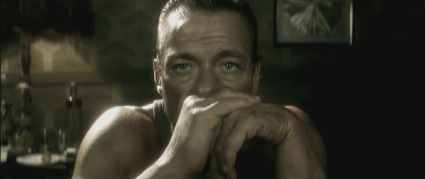
Mabrouk El Mechri - 2008
Musictronic Entertainment Region 3 DVD
If JCVD has done nothing else, it has proved how much good will Jean-Claude Van Damme has created, often in spite of, rather than because of his movies. This would be apparent from the critical acclamation given to this unexpected cult film. Playing at film festivals, and sneaking in and out of art houses doesn't exactly scream a return to the glory days of Universal Soldier. Why I think JVCD has created interest has to do with its look at the meaning of celebrity.
Van Damme portrays a fictionalized version of himself, returning to Brussels to take care of personal matters. Stepping out of a cab, two local men persuade Van Damme to pose for photos before he goes to a nearby bank to do some business. While the two men, a female cab driver, and a patrolling policeman discuss the presence of Van Damme in the town they describe as a "shit hole", shots are fired from the bank, shattering one of the taxi's windows. Seen briefly behind the bank window, it becomes clear that a bank robbery is in progress, and that Van Damme is involved.
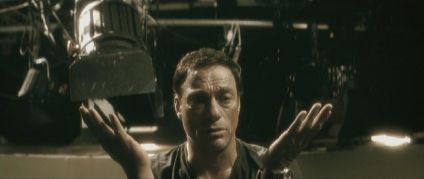
JCVD plays upon the expectations people have about celebrity, wanting the star to be both a "regular person" and simultaneously someone to be revered for their fame. At the same time, the character of Jean-Claude Van Damme finds himself in a situation where he cannot act like an action star in the film's version of real life. Still, Van Damme is asked to demonstrate one of his high kicks for one of the robbers, and gives advice from past films on how to negotiate with the police.
What I liked best was a scene, a monologue may well have been improvised. At one point inside the bank, Van Damme is literally lifted out of the scene to address the audience with a look back on his life. There is enough to suggest that without giving away specific details, Van Damme is reflecting on a life pretty close to his own.
One of the film's running jokes is about Van Damme giving John Woo his first Hollywood directing job. That Van Damme brought three top Hong Kong directors to Hollywood during a time of uncertainty in their own country is worthy of consideration. There is one scene of Van Damme making a film with a Chinese director that highlights the actors frustration with what he can do, and how a scene should be filmed, and the director's own indifference to the project. Again, JCVD plays with the notion of expectations between the real Jean-Claude Van Damme and his fictionalized screen character of the same name.
Whether JCVD will allow Jean-Claude Van Damme to get roles independent of his martial arts abilities has yet to be seen. Even if JCVD turns out to be an anomaly in a career of action films that continues, it may be enough for the moments of seeing a star famed for his grace in motion, showing a sense of grace about his life and career.
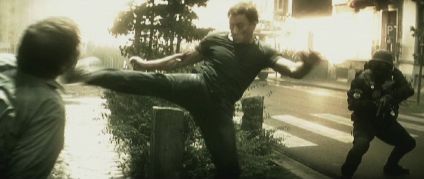
JCVD is available from HK Flix, where films are Bigger than Life.
Posted by Peter Nellhaus at 12:11 AM
March 17, 2009
Zero Focus

Zero no shoten
Yoshitaro Nomura - 1961
Home Vison Entertainment Region 1 DVD
I might be surprised, but I can not imagine the remake being as good as this first version by Yoshitaro Nomura. It should also be noted that Zero Focus was also included in a recent retrospective of Japanese Film Noir. And if the classic American film noir was a reflection of an anxious time following World War II, the same can be said for Nomura's film about life in post war Japan. Author Seicho Matsumoto has just begun to have his novels translated into English which will no doubt add to the currently fly-weight scholarship that exists on Nomura. Nomura is still under-represented in available English language subtitled DVDs.
Teiko, married for just a week, sees her husband off at a train station in Tokyo. Kenichi is an advertising executive visiting his old office, in northern Japan, to oversee the transition. Scheduled to return after twelve days, Kenichi is not heard from, either by Teiko, his brother, or his employer. Seeking some clues, Teiko discovers two photographs of two very different houses, one large, indicating financial fortune, the other, not much more than a dilapidated shack. The increasingly frantic Teiko travels to Kanazawa, where Kenichi was last seen. Following some false leads, misinterpreting clues, Teiko finally learns some unexpected truths about Kenichi.

Had Zero Focus not been based on a novel by Matsumoto, one could easily assume that the story was inspired by Cornell Woolrich. Some of the story elements, an impulsive marriage between two virtual strangers, a husband who seemingly disappears, and shameful hidden pasts are reminiscent of the author of Phantom Lady and The Bride wore Black. As in Nomura's best film, Castles of Sand, the screenplay is by Shinobu Hashimoto and Yoji Yamada. At this time I have no way of qualifying how much of the film was already in Matsumoto's novel, but much of Zero Focus plays like an homage to American film noir in the fractured narrative.
The film begins with first person narration by Yoshiko Kuga as Teiko. The very opening made me think of Hitchock's Rebecca. While trying to find out about the whereabout of Kenichi, there are flashbacks from the point of view of different characters. Eventually, Teiko explains what she has assumed to be what has happened to Kenichi and some other characters. Teiko's stories are contradicted by Sachiko, the youngish wife of a much older Kanazawa industrialist. The differing stories, shown in flashbacks, may have taken its queues from Hitchcock's Stage Fright. In both cases, the filmmaker plays on the audience assumption that what is being viewed is as the objective truth. It is probably also worth noting that Nomura served as an assistant to Akira Kurosawa, so that Roshomon could have been another influence. In her demeanor, Kuga reminded me of such mousy Hitchcock heroines as Joan Fontaine and Jane Wyman.
There is something of a critique of Japanese women and how they are perceived in Japanese society. Teiko is newly married at the age of 36, comparatively old by Japanese standards then and even now. She would probably be assumed to have still been a virgin. This point is important because Teiko is contrasted with women who turned to prostitution to survive in post war Japan. In a symbolic way, Zero Focus is about Teiko's loss of moral virginity. While she is not corrupted by others, she is forced to confront realities of lives outside of her sheltered existence in Tokyo. The snow, with its vast whiteness, acts as a symbol of Teiko's purity. The most beautiful place in Kanazawa, a cliff overlook the sea, is also know as a popular spot to commit suicide by falling onto the rocks below. The snow serves a second purpose in Zero Focus, as a reminder of surface beauty covering something less attractive and deadly underneath.

Posted by Peter Nellhaus at 12:04 AM
March 15, 2009
Coffee Break
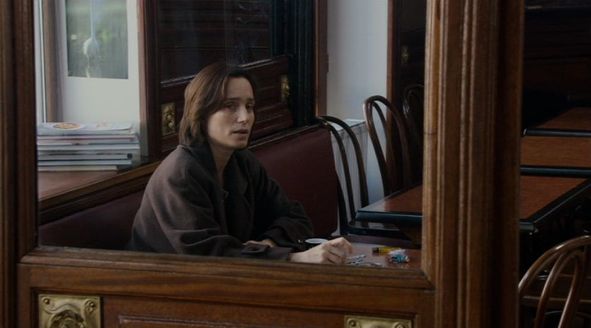
Kristen Scott Thomas in I've Loved You So Long (Philippe Claudel - 2008)
Nathaniel R has loved Kristen Scott Thomas so long as well. Here is his podcast.
Posted by Peter Nellhaus at 12:23 AM
March 13, 2009
Scott Walker: 30 Century Man
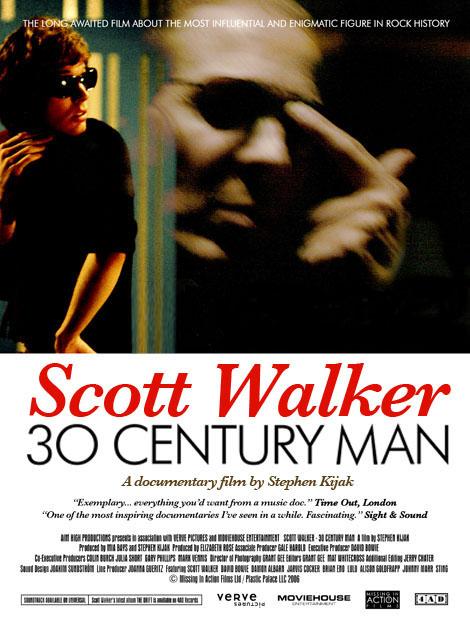
Stephen Kijak - 2007
Oscilloscope Pictures 35mm Film
If there was ever a movie to be seen in a state of the art movie theater with digital surround sound, it would be this documentary on Scott Walker. Not that I would expect more than the ten or so people who showed at the showing I attended, but hearing the music under optimal conditions would have certainly enhanced the film as well as the argument that Walker may be one of the more adventurous composers of our time. As the film continued, I had wondered what I had missed, allowing Scott Walker to fall out of my radar sometime after the last Walker Brothers top ten hit.
What I didn't realize was that I wasn't paying close attention to the music in my life. I had seen the film he scored, Leos Carax's Pola X, as well as The Aquatic Life of Steve Zissou which had "30 Century Man" on the soundtrack. I even have Ute Lemper's album. Punishing Kiss, with the song "Scope J". The Stephen Kijac's film accomplishes is showing the evolution of Scott Walker from a pop star who outgrew playing to his teenage fan base, to someone whose musical composition defy the convention definition of song writing.
In discussing Scott Walker's early years in Europe, it is mentioned about his taste in European films, the kind of work that played in U.S. "art" theaters. Walker's taste in film included Ingmar Bergman and Carl Dreyer which hints at the eventual direction of his life and art. While only touched upon, a review of both the Walker Brothers discography and Scott Walker's solo work indicates that there has always been a consistent interest in film expressed in some of the choices of songs written by others as well as Scott Walker's own work. One of Scott Walker's albums is titled The Moviegoer, which may have been an innocuous title for an album of movie themes. The title could well have been a nod to Walker Percy's novel, The Moviegoer. One could liken Walker to Binx Bolling in that his life was defined by the conflicts between his own musical explorations and desire to express himself on his own terms, with a continued search for different forms of musical expression and sounds, against the commercial demands and expectations of producers and an increasingly indifferent public. Even a casual listen to Walker's song reveal recurring themes of solitude and existential concerns.
While Walker's The Moviegoer has the very commercial themes from The Godfather and "Come Saturday Morning" from The Sterile Cookoo, I suspect Walker chose the songs from Joe Hll and Sacco and Vanzetti. In the album Tilt, one of the song titles is "Farmer in the City (Remembering Pasolini)", with lyrics from one of Pasolini's poems. In the earlier Climate at Hunter, the song "Blanket Roll Blues" is from a poem by Tennessee Williams. In one quote, Scott Walker compares himself to Orson Welles, in that both find it easy to find people who express admiration for them as artists, but find it a struggle to finance their respective art. At one point in the documentary on Walker, we see a "poem" written by some disgruntled former fans who feel betrayed by Walker's choice to move on artistically. Scott Walker's life has been one of choosing artistic authenticity, to borrow the title from a Moody Blues' album, a search for a lost chord.

Telling the tale, in addition to Walker, are some of Walker's artistic collaborators as well as musician-fans, such as the film's Executive Producer, David Bowie, looking far to good for a man his age, and Lulu, still cute for the other side of Fifty. There's some documentary footage of The Walker Brothers in performance, and animated song lyrics from some of Scott Walker's songs. I might not have bothered seeing this film if it hadn't been for the review by Tim Lucas. (I swear it's coincidence that this is my second Lucas inspired piece in one week.) The best reason to see Scott Walker: 30 Century Man in a theater is that if you'r like me, you probably won't be able to have the music quite as loud at home.
Posted by Peter Nellhaus at 12:13 AM | Comments (1)
March 10, 2009
Crouching Tiger, Hidden Bava
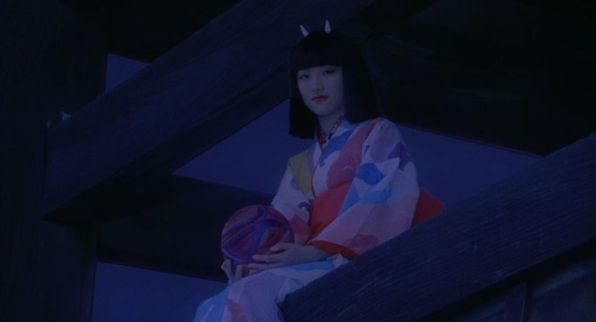
A piece by Tim Lucas that I hope others have read is about the Devil as a young girl in Bunuel's Simon of the Desert. I thought back to that piece as I viewed Ashura. This more recent Japanese film has a devil that is closer to those found in Fellini and Bava's films as she is seen with a ball. The character of Emishi, played by Hanae Kan, is more literal, with a small pair of horns on her head.
I saw this film, along with When the Last Sword is Drawn, to get some idea of Yojiro Takita work prior to his Oscar winning Departures. Nothing I saw would have made me predict that Takita would even be a nominee. While the Japanese Academy named When the Last Sword is Drawn the the best film, along with honoring the two male leads, in 2004, my own preference would have been for Takeshi Kitano's Zatoichi. Takita's film about the uneasy friendship and rivalry between two 19th Century samurai was the least interesting as a samurai film. The subplot about the two men's relationships with the women of their lives caught my interest, and suggests the warmhearted aspect to Takita's work that was noted in a review of Departures.
Ashura is a bagful of loopy fun. A gang of "wardens" search for demons that spurt phosphorescent green blood when cut. One of the wardens leaves to become an itinerant actor, a popular Kabuki star. A young woman finds a mysterious mark on her shoulder that grows. The presence of Ashura means that demons will take over the world, with Ashura residing in an invisible upside down castle. AnimEigo's wonderfully vernacular subtitles may add more snark than intended, but it adds to the fun of a film that seems to be a grab bag of bits from An Actor's Revenge, Shakespeare in Love, Spider-Man, as well as the memory of years of Japanese samurai films. Was the devil girl with the ball inspired by Fellini or Bava? Maybe when more of Takita is known, we'll find out. Whatever the case, the character of Emishi as she appears in Ashura is both iconic and unexpected.
Posted by Peter Nellhaus at 12:35 AM | Comments (4)
March 08, 2009
Coffee Break
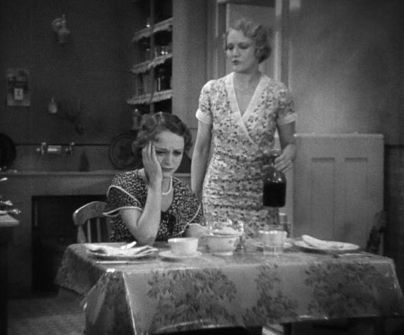
Sally Eilers and Mina Gombell in Bad Girl (Frank Borzage - 1931)
Posted by Peter Nellhaus at 12:19 AM
March 05, 2009
Wonderful Town

Aditya Assarat - 2007
Kino International Region 1 DVD
While most people were paying attention to the Academy Awards, the Thai film industry had its own industry award show. The big winner of the Subanahongsa Awards was Wonderful Town. What makes the slew of awards more remarkable is that the film film was a true independent production without the backing of any of the Thai studios, and was screened in limited release in Thai theaters. Wonderful Town also is unlike most Thai narrative films currently being made. While more polished, there were aspects of the film that reminded me of some of the "mumblecore" films, with the simplicity of the story and story-telling, especially in the trust of allowing stillness and quiet, of letting images speak for themselves.
Ton, a young architect, is in a small coastal town in southern Thailand. His job is to nominally supervise the reconstruction of a resort damaged by the tsunami of 2004. He stays in a run down hotel further in town, run almost single-handedly by Na, a young woman who inherited the hotel from her parents. The hotel is virtually empty as is the town which was decimated first by a tourist industry that concentrated on the beach, and again by tsunami that destroyed the beach. Ton states that he stays in the hotel in town because it is quiet. While there, he begins flirting with Na, a relationship that eventually becomes more serious between the two.

Aditya's film is in part about the act of observation. The first shot is of the waves on the beach, followed by a close up of Na sleeping at the hotel desk. The music score is from an understated acoustic guitar. Very little is stated outright, either by Aditya or his characters. Na's romantic longing for Ton is shown by a shot of her hand caressing the bed that Ton had slept in. The influence of Apichatpong Weerasethakul can be seen in some of the exterior shots, the sound of the wind while it pushes against the overgrown grass. One of the most pleasurable images is of a barefoot child, unseen under a raincoat, kicking puddles in the rain.
One scene that marked Wonderful Town as inescapably Thai was when Ton looks into a house next to the rebuilt resort. Before stepping in, Ton is warned that the place is haunted. Even when they are not manifest, ghosts, or even the idea of possible ghosts, are firmly embedded in Thai culture. Ton walks through the damaged interior, picking up and discarding the few reminders, such as a book, of the former residents. Damaged by time and disuse is the former home of Na, one of the crumbling reminders of a more prosperous past. Ton is viewed with suspicion by the residents of the small town not only because he is an outsider, from Bangkok, but because he represents a future that can not be stopped, further distancing the town from the modest success it may have held previously.
Na mentions that she had a college education in one of the cities. She never explains why she returned to the small town, although it is suggested that it is because of the sense of family obligation. Her brother also remains in the town, seeming to do nothing more than mark time. Even Ton is revealed to have not fully escaped from his previous career as a musician. In Wonderful Town, the past determines the present lives of the characters, whether they consciously try to rebel or resign themselves to what appears to be a predestined fate.
Here is an interview with Aditya Assarat.

Posted by Peter Nellhaus at 12:21 AM | Comments (2)
March 03, 2009
Three Kingdoms: Resurrection of the Dragon

Saam gwok dzi gin lung se gap
Daniel Lee - 2008
Sun Jian Media All Region DVD
Henry Lai's score to Three Kingdoms owes plenty to Ennio Morricone. Much of the music is reminders of the scores used in the westerns by Sergio Leone. I know I'm not the only one who felt that way about the music. I liked it so much that it gave me reason to watch the DVD until the very end, listening to the heavy drums.
Lee's film was the first of two films two be released inspired by the Chinese literary classic, "Romance of Three Kingdoms". The other film, actually in two parts, is by John Woo, with a much bigger budget. Lee's film is smaller in scope though still with epic battle scenes. In scanning the other reviews of the film, there is some consistency in noting that the film seems truncated. The running time of the version I saw was ninety-seven minutes. Many sources give the running time as 102 minutes. The difference could be written off to a conversion speed of 25 frames per second. Because of the relatively compact running time, with some characters appearing too briefly, there is the question as to whether this was the film Daniel Lee intended to make. Even though the film was still expensive by Chinese standards, though less than Peter Chan's The Warlords or Woo's Red Cliff, it seems like the end result was less than it could have been.

This is a fictionalized version of Chinese history with Sammo Hung as a soldier who recruits Andy Lau to fight for one of the three emperors battling to unite China. Lau abilities as a soldier quickly elevate him in the ranks until he becomes one of the top generals. Hung remains a humble foot soldier watching Lau from further distances. Hung declares himself to be a person of great dreams and ambitions. Hung and Lau's story could be said to be about the deferment of personal dreams for an ideal greater than themselves. Even though Lau ascends to military leadership, his sense of loyalty to Hung remains solid, initially covering for Hung's incompetence without acknowledgment, as well as protecting the person he calls "brother" from execution.
The fictionalization goes a bit further with Maggie Q as the granddaughter of an opposing general, a character created for the film. Artistic license beats history with the sight of Maggie Q in a fur lined costume, with long, metal fingernails, playing a pipa, a Chinese stringed instrument. The sight of her in battle against Andy Lau is a reminder of her talent in martial arts, with sword, spear, or just kicking ass.
Had Daniel Lee perhaps been more trusting of his material, a good film could have been better. The action sequences, directed by Hung, have too much hyper-editing, slo-mo, and digital manipulation. The effect is as if the filmmakers wanted something between the gritty realism of The Warlords and the magic of Crouching Tiger, Hidden Dragon but did not achieve either goal. The most thrilling scene is of Andy Lau battling, on horseback and on foot, hundreds of soldiers, with a baby tied to his back, a scene that may intentionally recall Chow Yun-Fat holding a baby in one arm while shooting it out in Hard-Boiled.
For those interested, here is an interview with Lee about the making of Three Kingdoms.

Posted by Peter Nellhaus at 12:11 AM | Comments (1)
March 01, 2009
Coffee Break

Jeong Bo-seok and Lee Eun-Ju in The Virgin Stripped Bare by Her Bachelors (Hong Sang-soo -2000)
Posted by Peter Nellhaus at 10:21 AM | Comments (1)
